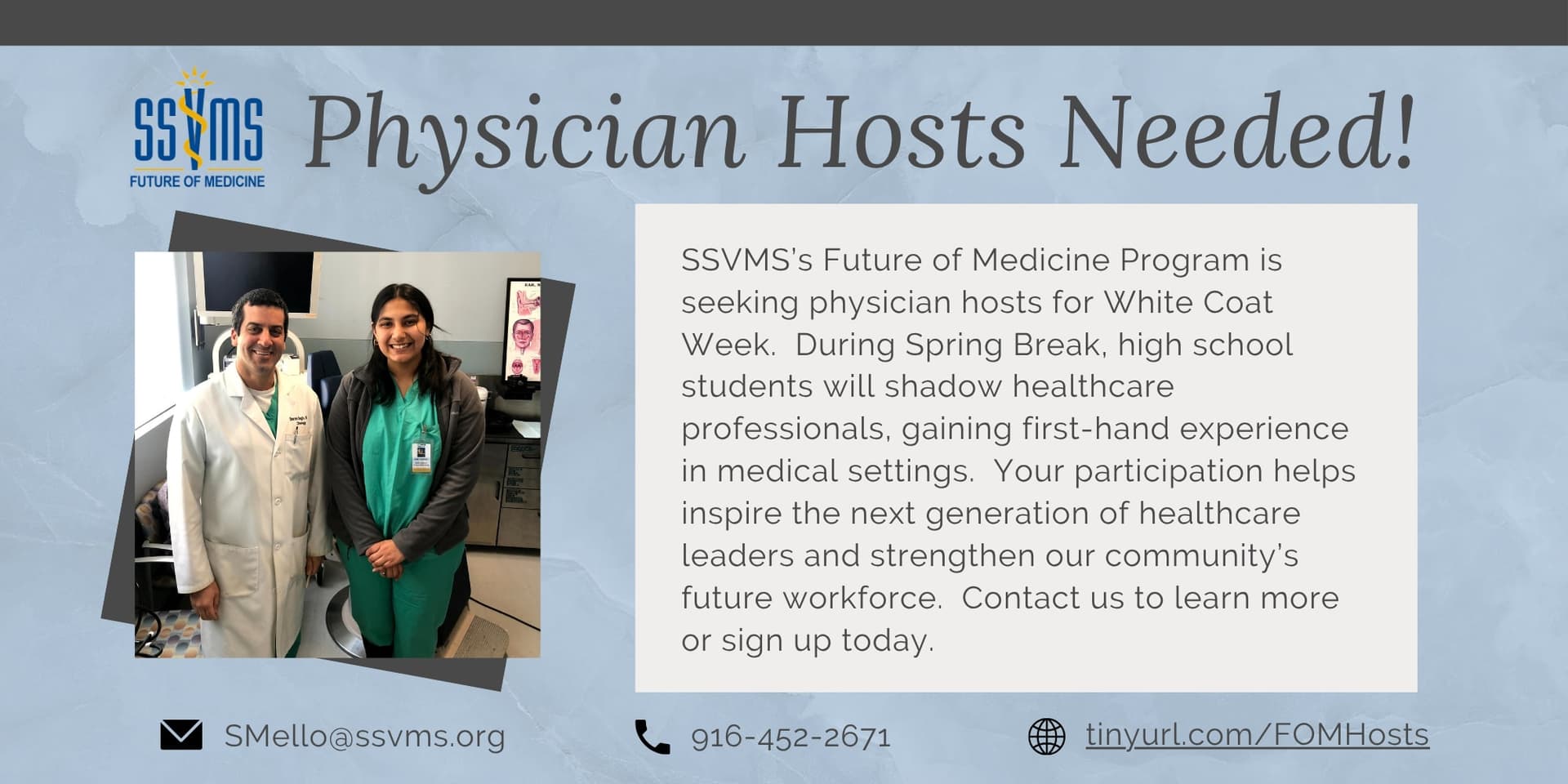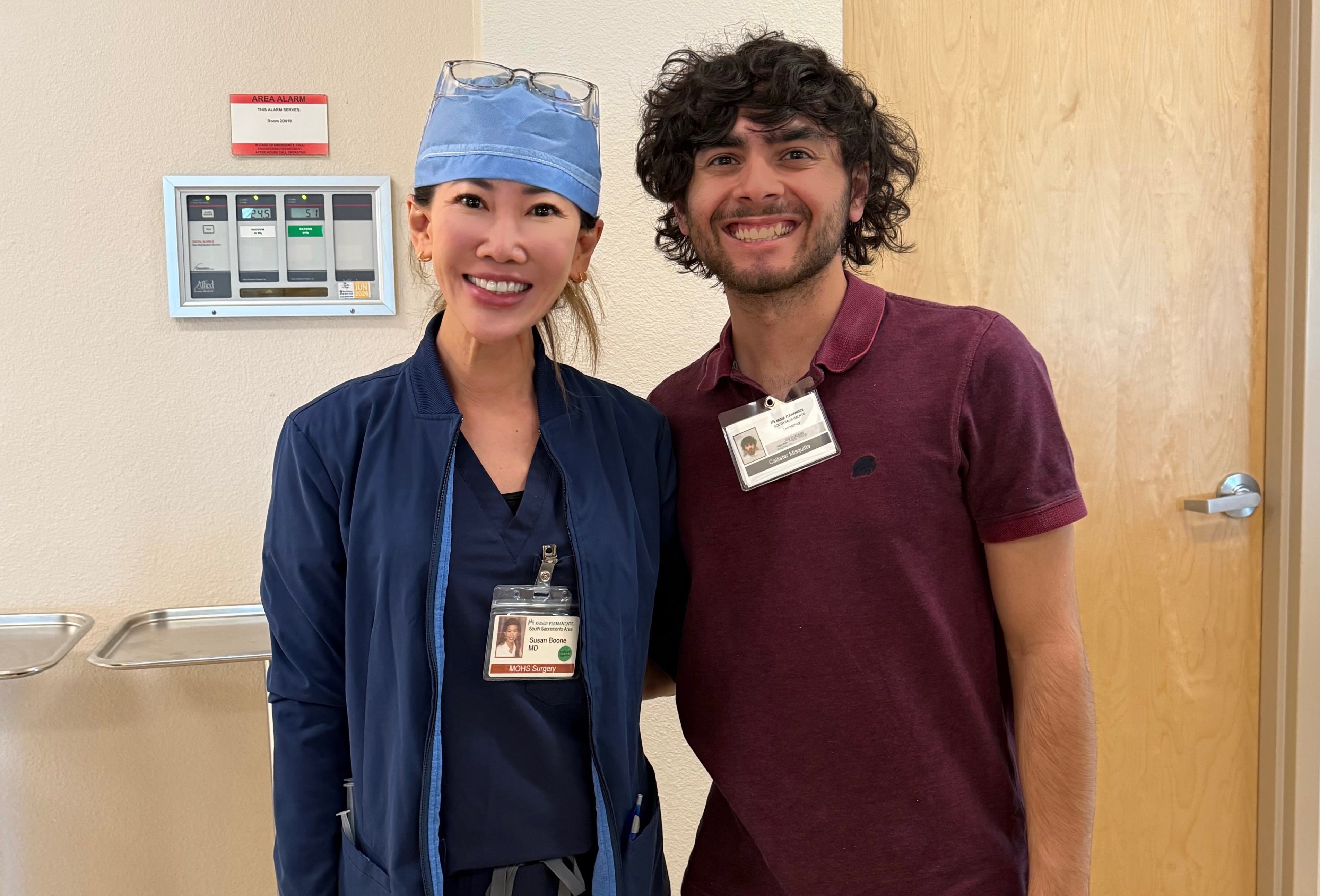Cover Photo:
The author with Dr. Susan Boone, Dermatology, at Kaiser South Sacramento Medical Center
Walking from the clinic to the emergency department, I couldn't help but feel a mix of excitement and nervousness. I was stepping into the shoes of the doctors I aspired to become. Little did I know this experience would not only solidify my passion for medicine, but also provide me with invaluable insight into the world of healthcare.
The nephrologist I had been shadowing that morning introduced me to an emergency medicine physician amidst a whirlwind of activity. While nurses hurried past to care for ailing patients, the doctor agreed to set me up with all the interesting cases that came in that day. He said he would introduce me to different doctors as they treated patients that afternoon.
After watching one physician perform a thoracentesis, I was guided to another area where the physicians were resuscitating a patient, with several doctors and nurses in attendance. The atmosphere was intense yet organized, with one physician providing clear directions to everybody caring for the patient. Everyone managed their role with skill and expertise.
Another day, I shadowed a radiation oncologist. I observed him as he interacted with patients, explaining complex medical terms in a way that was both compassionate and easy to understand. For one patient, he also laid out a couple of treatment options specific to her condition after her recent tumor resection, describing the pros and cons of each option and allowing the patient to make decisions about her care. I was inspired by his ability to connect with patients on a personal level while maintaining a high level of professionalism.
Many times, I heard patients tell me how good their physicians were. I specifically remember every patient in the GI surgery clinic claiming how the doctor I was shadowing was the best surgeon ever. I also appreciated the extra time physicians took with me to explain their thought processes. Some even quizzed me, an undergraduate, on some basic causes of disease.
I spent a few days shadowing a MOHS surgeon, which was an amazing experience for a student because I not only got to see the procedures, but also the real-time evaluation of each patient’s outcome. The surgeon had a microscope set up with two sets of eyepieces that enabled her to show me the sections of tissue she excised on multiple slides and what she was evaluating to determine whether additional resections were necessary.
In addition to the above experiences, I shadowed physicians in internal medicine, radiology (including interventional), pediatric infectious disease, and ophthalmology. This was critical for me to get a window into what I hope will be my future profession. Most students aren’t as lucky as I am, and I understand that all the physicians I shadowed gave their time as a favor to my father, who made many friends during his time in practice. I had an array of experiences with exposure to different fields in medicine and types of practice. The physicians I shadowed spent extra time with me, a precious commodity in their very busy days. On top of seeing patients, checking labs, writing notes, following up on calls and emails, and everything else that takes up time in a physician’s day, having a student shadow can be challenging.
However, most medical schools encourage candidates to obtain 50-100 hours of shadowing with 2-4 specialties to remain competitive in the application process. I reached out to Dr. Ed Lee, Chair of Clinical Education and Director of Clinical Informatics at California Northstate University College of Medicine. “I think it shows the candidate is committed to a career in medicine and has an idea of what they are getting into as they advance through their education and training,” Dr. Lee said. “And if they haven’t had shadowing experience, how do they know it's the career path they want to take?”
This can be a big obstacle to students who may be the first in their family to consider studying medicine. Fortunately, the SSVMS has established the Future of Medicine, a mentoring program to build similar experiences for high school and undergraduate students. I spoke with Sam Mello-Edwards, SSVMS Program and Events Manager, who runs the Future of Medicine. She has been working with health systems in the Sacramento area to garner support and volunteers for the program, which matches high school and undergraduate students with physicians and other professionals to cultivate the next generation of health care providers.
To find students interested in medical fields, Mello-Edwards works with school districts and high schools in the area, such as San Juan, Cordova, Natomas, and St. Francis. She attends career fairs and conducts class discussions to recruit students to the program.
"Shadowing provides premed students with a unique opportunity to gain firsthand experience in the medical field. It allows them to see the realities of healthcare and helps them make informed decisions about their future careers," Mello-Edwards said. She also mentioned that many physicians who have participated in the SSVMS mentoring program volunteer multiple times, providing critical leadership to attract students and address the growing physician shortage.
I spoke with Kavita Thornton, a high school student who participated in the Future of Medicine program. She explained how the program exposed students to suturing and casting fractures, and also taught them how to perform CPR and administer NARCAN. “I highly recommend this to other kids interested in medicine because it gives you a deeper perspective into what doctors and medical staff do,” Thornton said. “I believe this can help kids narrow down their interests [in medicine].”
However, the program does not have enough spots for all its applicants. It is a competitive program with only 56 slots, and the last round received 150 applications. The main reason the program has limited spots is due to the difficulty of recruiting physicians to volunteer and take students.

“It is challenging to get physicians to participate… [however,] once they're interested, they're willing to do it again and again,” said Mello-Edwards. Currently, Kaiser and UC Davis host students through the program, and SSVMS is looking for other health systems to participate. While it would be beneficial for students to also experience the work of private practice physicians, those offices are often heavily impacted by the number of patients private practice doctors see per day and are unable to take students.
I’m deeply grateful to the doctors who welcomed me into their practices. Their willingness to share their knowledge and experiences with me was a gift I will forever cherish. I am especially thankful for their mentorship and guidance, and I hope to someday play a similar role for others.



